Competitive Strategies of Toyota and Samsung: A Comparative Analysis
VerifiedAdded on 2020/03/02
|6
|1447
|35
Report
AI Summary
This report provides a comparative analysis of the competitive strategies employed by Toyota and Samsung. The report examines Toyota's lean manufacturing processes, cost leadership, product differentiation, and intensive growth strategies, highlighting its success in the global automotive market. It explores how Toyota leverages 'just-in-time' manufacturing and innovation to gain a competitive edge. The analysis then shifts to Samsung, detailing its strategies in the smartphone market, including pricing, supply chain management, product diversification, and innovation in technology and marketing. The report emphasizes Samsung's use of competitive pricing, research and development, and marketing strategies to capture market share, even against strong competitors like Apple. The report references various academic sources to support its analysis, offering insights into how these companies have achieved and maintained their global success through strategic business practices.
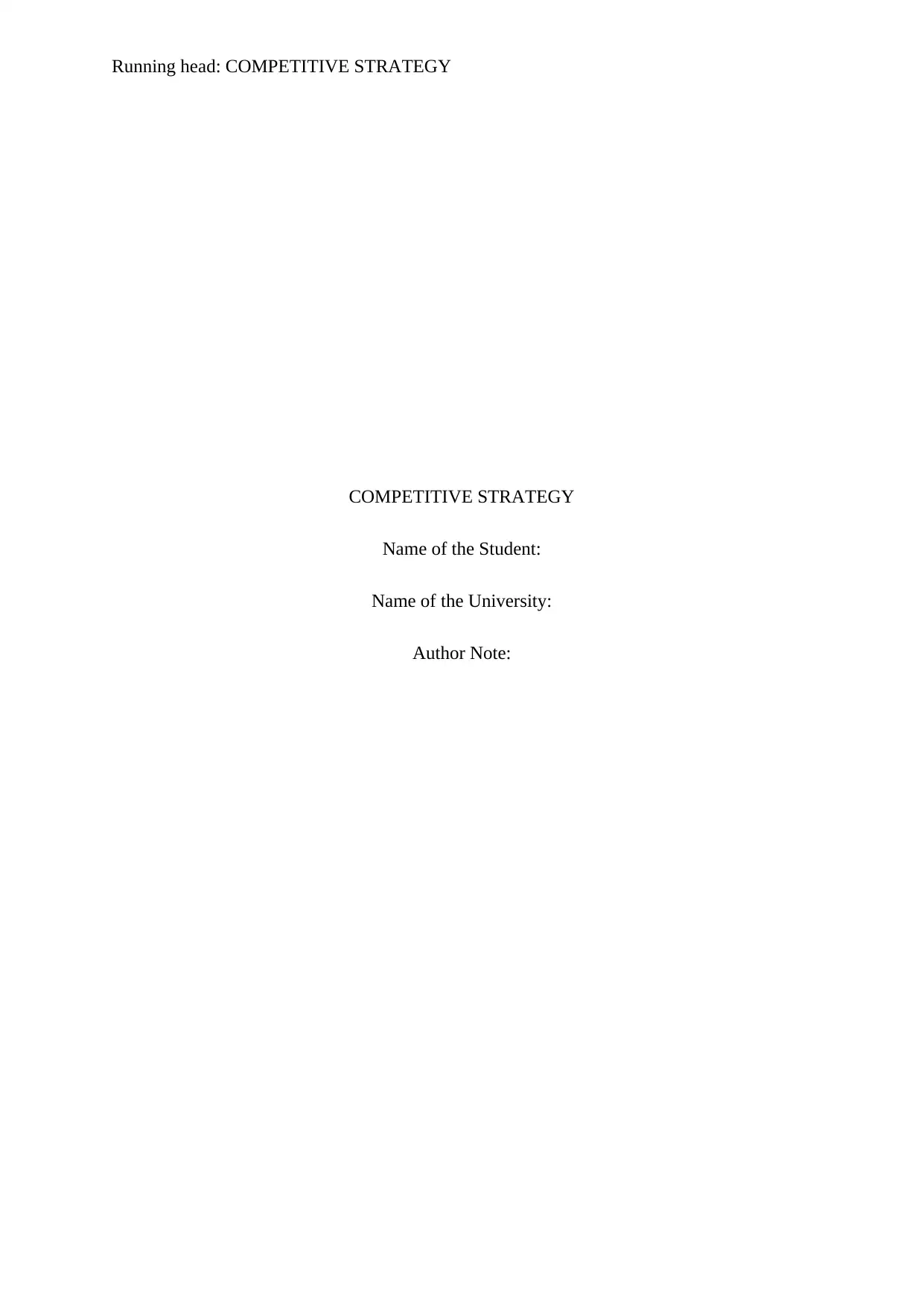
Running head: COMPETITIVE STRATEGY
COMPETITIVE STRATEGY
Name of the Student:
Name of the University:
Author Note:
COMPETITIVE STRATEGY
Name of the Student:
Name of the University:
Author Note:
Paraphrase This Document
Need a fresh take? Get an instant paraphrase of this document with our AI Paraphraser
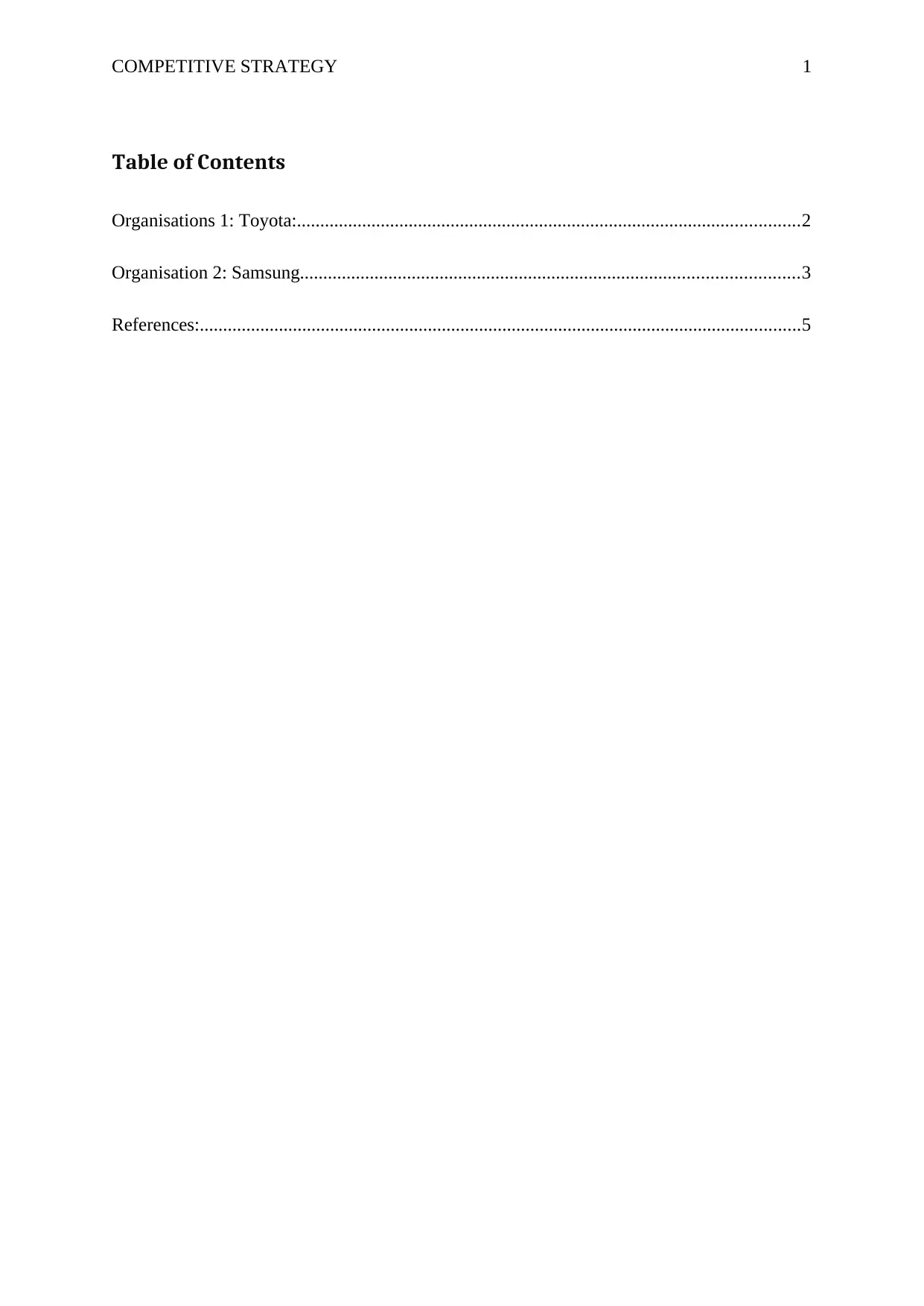
COMPETITIVE STRATEGY 1
Table of Contents
Organisations 1: Toyota:............................................................................................................2
Organisation 2: Samsung...........................................................................................................3
References:.................................................................................................................................5
Table of Contents
Organisations 1: Toyota:............................................................................................................2
Organisation 2: Samsung...........................................................................................................3
References:.................................................................................................................................5
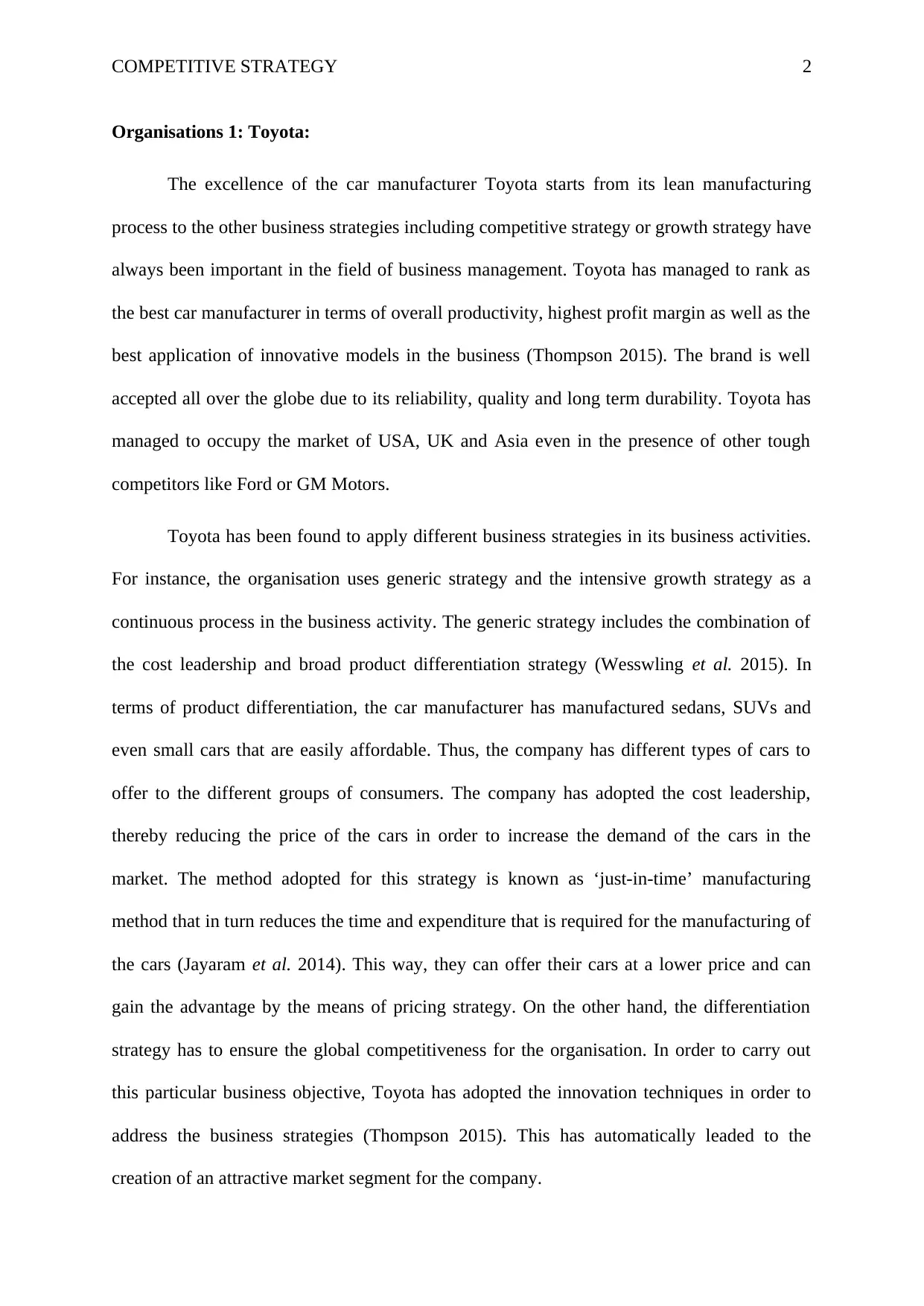
COMPETITIVE STRATEGY 2
Organisations 1: Toyota:
The excellence of the car manufacturer Toyota starts from its lean manufacturing
process to the other business strategies including competitive strategy or growth strategy have
always been important in the field of business management. Toyota has managed to rank as
the best car manufacturer in terms of overall productivity, highest profit margin as well as the
best application of innovative models in the business (Thompson 2015). The brand is well
accepted all over the globe due to its reliability, quality and long term durability. Toyota has
managed to occupy the market of USA, UK and Asia even in the presence of other tough
competitors like Ford or GM Motors.
Toyota has been found to apply different business strategies in its business activities.
For instance, the organisation uses generic strategy and the intensive growth strategy as a
continuous process in the business activity. The generic strategy includes the combination of
the cost leadership and broad product differentiation strategy (Wesswling et al. 2015). In
terms of product differentiation, the car manufacturer has manufactured sedans, SUVs and
even small cars that are easily affordable. Thus, the company has different types of cars to
offer to the different groups of consumers. The company has adopted the cost leadership,
thereby reducing the price of the cars in order to increase the demand of the cars in the
market. The method adopted for this strategy is known as ‘just-in-time’ manufacturing
method that in turn reduces the time and expenditure that is required for the manufacturing of
the cars (Jayaram et al. 2014). This way, they can offer their cars at a lower price and can
gain the advantage by the means of pricing strategy. On the other hand, the differentiation
strategy has to ensure the global competitiveness for the organisation. In order to carry out
this particular business objective, Toyota has adopted the innovation techniques in order to
address the business strategies (Thompson 2015). This has automatically leaded to the
creation of an attractive market segment for the company.
Organisations 1: Toyota:
The excellence of the car manufacturer Toyota starts from its lean manufacturing
process to the other business strategies including competitive strategy or growth strategy have
always been important in the field of business management. Toyota has managed to rank as
the best car manufacturer in terms of overall productivity, highest profit margin as well as the
best application of innovative models in the business (Thompson 2015). The brand is well
accepted all over the globe due to its reliability, quality and long term durability. Toyota has
managed to occupy the market of USA, UK and Asia even in the presence of other tough
competitors like Ford or GM Motors.
Toyota has been found to apply different business strategies in its business activities.
For instance, the organisation uses generic strategy and the intensive growth strategy as a
continuous process in the business activity. The generic strategy includes the combination of
the cost leadership and broad product differentiation strategy (Wesswling et al. 2015). In
terms of product differentiation, the car manufacturer has manufactured sedans, SUVs and
even small cars that are easily affordable. Thus, the company has different types of cars to
offer to the different groups of consumers. The company has adopted the cost leadership,
thereby reducing the price of the cars in order to increase the demand of the cars in the
market. The method adopted for this strategy is known as ‘just-in-time’ manufacturing
method that in turn reduces the time and expenditure that is required for the manufacturing of
the cars (Jayaram et al. 2014). This way, they can offer their cars at a lower price and can
gain the advantage by the means of pricing strategy. On the other hand, the differentiation
strategy has to ensure the global competitiveness for the organisation. In order to carry out
this particular business objective, Toyota has adopted the innovation techniques in order to
address the business strategies (Thompson 2015). This has automatically leaded to the
creation of an attractive market segment for the company.
⊘ This is a preview!⊘
Do you want full access?
Subscribe today to unlock all pages.

Trusted by 1+ million students worldwide
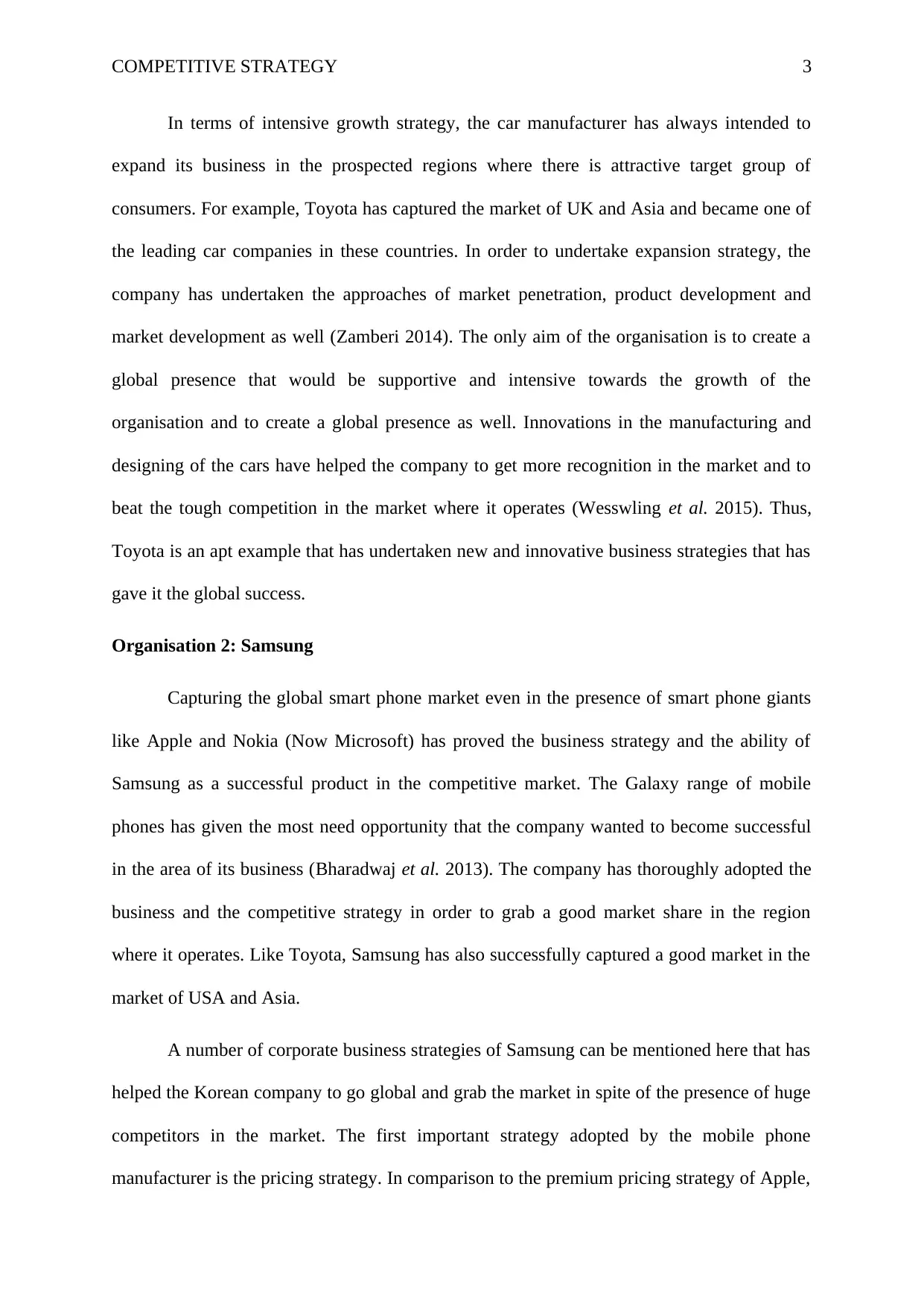
COMPETITIVE STRATEGY 3
In terms of intensive growth strategy, the car manufacturer has always intended to
expand its business in the prospected regions where there is attractive target group of
consumers. For example, Toyota has captured the market of UK and Asia and became one of
the leading car companies in these countries. In order to undertake expansion strategy, the
company has undertaken the approaches of market penetration, product development and
market development as well (Zamberi 2014). The only aim of the organisation is to create a
global presence that would be supportive and intensive towards the growth of the
organisation and to create a global presence as well. Innovations in the manufacturing and
designing of the cars have helped the company to get more recognition in the market and to
beat the tough competition in the market where it operates (Wesswling et al. 2015). Thus,
Toyota is an apt example that has undertaken new and innovative business strategies that has
gave it the global success.
Organisation 2: Samsung
Capturing the global smart phone market even in the presence of smart phone giants
like Apple and Nokia (Now Microsoft) has proved the business strategy and the ability of
Samsung as a successful product in the competitive market. The Galaxy range of mobile
phones has given the most need opportunity that the company wanted to become successful
in the area of its business (Bharadwaj et al. 2013). The company has thoroughly adopted the
business and the competitive strategy in order to grab a good market share in the region
where it operates. Like Toyota, Samsung has also successfully captured a good market in the
market of USA and Asia.
A number of corporate business strategies of Samsung can be mentioned here that has
helped the Korean company to go global and grab the market in spite of the presence of huge
competitors in the market. The first important strategy adopted by the mobile phone
manufacturer is the pricing strategy. In comparison to the premium pricing strategy of Apple,
In terms of intensive growth strategy, the car manufacturer has always intended to
expand its business in the prospected regions where there is attractive target group of
consumers. For example, Toyota has captured the market of UK and Asia and became one of
the leading car companies in these countries. In order to undertake expansion strategy, the
company has undertaken the approaches of market penetration, product development and
market development as well (Zamberi 2014). The only aim of the organisation is to create a
global presence that would be supportive and intensive towards the growth of the
organisation and to create a global presence as well. Innovations in the manufacturing and
designing of the cars have helped the company to get more recognition in the market and to
beat the tough competition in the market where it operates (Wesswling et al. 2015). Thus,
Toyota is an apt example that has undertaken new and innovative business strategies that has
gave it the global success.
Organisation 2: Samsung
Capturing the global smart phone market even in the presence of smart phone giants
like Apple and Nokia (Now Microsoft) has proved the business strategy and the ability of
Samsung as a successful product in the competitive market. The Galaxy range of mobile
phones has given the most need opportunity that the company wanted to become successful
in the area of its business (Bharadwaj et al. 2013). The company has thoroughly adopted the
business and the competitive strategy in order to grab a good market share in the region
where it operates. Like Toyota, Samsung has also successfully captured a good market in the
market of USA and Asia.
A number of corporate business strategies of Samsung can be mentioned here that has
helped the Korean company to go global and grab the market in spite of the presence of huge
competitors in the market. The first important strategy adopted by the mobile phone
manufacturer is the pricing strategy. In comparison to the premium pricing strategy of Apple,
Paraphrase This Document
Need a fresh take? Get an instant paraphrase of this document with our AI Paraphraser
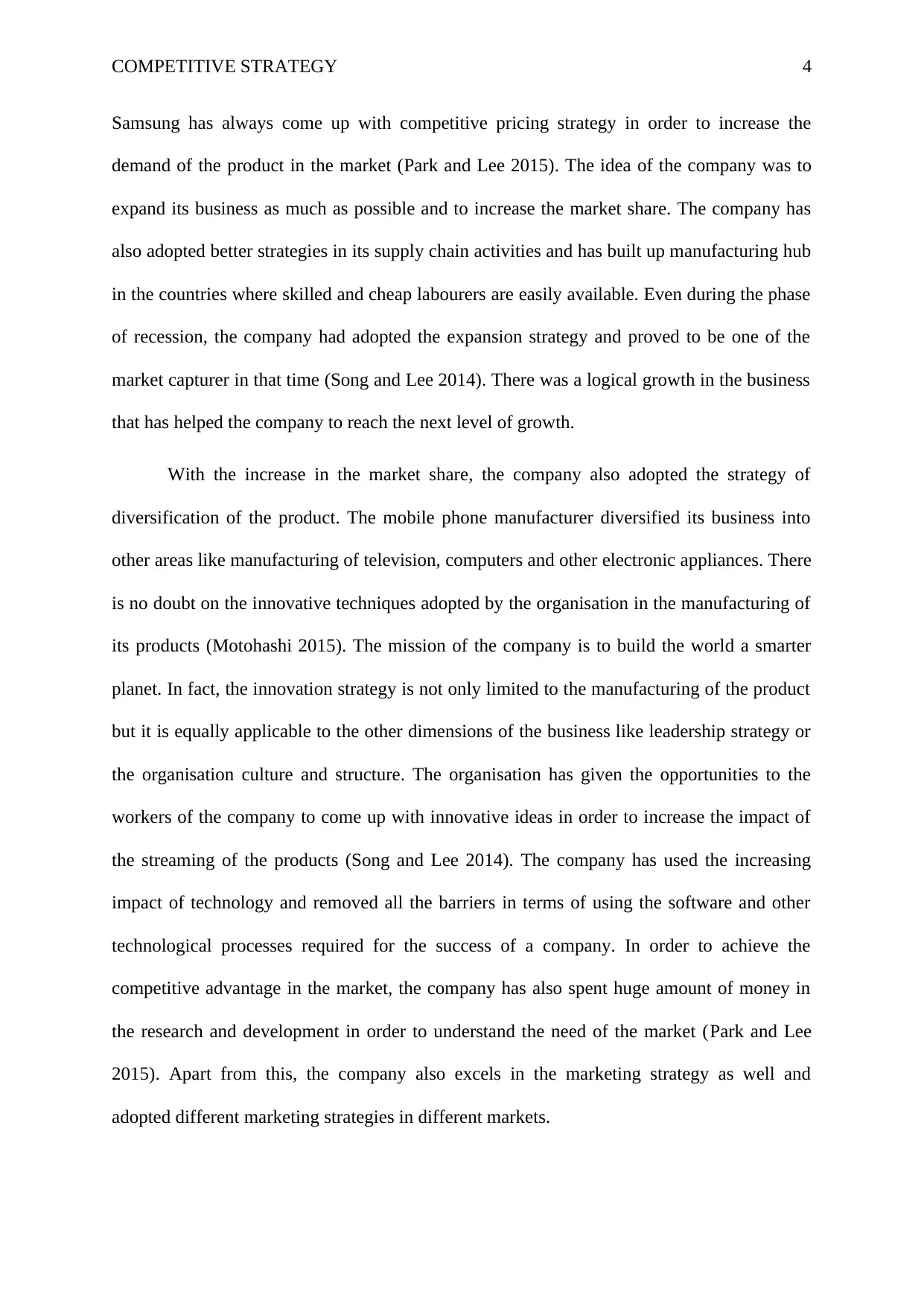
COMPETITIVE STRATEGY 4
Samsung has always come up with competitive pricing strategy in order to increase the
demand of the product in the market (Park and Lee 2015). The idea of the company was to
expand its business as much as possible and to increase the market share. The company has
also adopted better strategies in its supply chain activities and has built up manufacturing hub
in the countries where skilled and cheap labourers are easily available. Even during the phase
of recession, the company had adopted the expansion strategy and proved to be one of the
market capturer in that time (Song and Lee 2014). There was a logical growth in the business
that has helped the company to reach the next level of growth.
With the increase in the market share, the company also adopted the strategy of
diversification of the product. The mobile phone manufacturer diversified its business into
other areas like manufacturing of television, computers and other electronic appliances. There
is no doubt on the innovative techniques adopted by the organisation in the manufacturing of
its products (Motohashi 2015). The mission of the company is to build the world a smarter
planet. In fact, the innovation strategy is not only limited to the manufacturing of the product
but it is equally applicable to the other dimensions of the business like leadership strategy or
the organisation culture and structure. The organisation has given the opportunities to the
workers of the company to come up with innovative ideas in order to increase the impact of
the streaming of the products (Song and Lee 2014). The company has used the increasing
impact of technology and removed all the barriers in terms of using the software and other
technological processes required for the success of a company. In order to achieve the
competitive advantage in the market, the company has also spent huge amount of money in
the research and development in order to understand the need of the market (Park and Lee
2015). Apart from this, the company also excels in the marketing strategy as well and
adopted different marketing strategies in different markets.
Samsung has always come up with competitive pricing strategy in order to increase the
demand of the product in the market (Park and Lee 2015). The idea of the company was to
expand its business as much as possible and to increase the market share. The company has
also adopted better strategies in its supply chain activities and has built up manufacturing hub
in the countries where skilled and cheap labourers are easily available. Even during the phase
of recession, the company had adopted the expansion strategy and proved to be one of the
market capturer in that time (Song and Lee 2014). There was a logical growth in the business
that has helped the company to reach the next level of growth.
With the increase in the market share, the company also adopted the strategy of
diversification of the product. The mobile phone manufacturer diversified its business into
other areas like manufacturing of television, computers and other electronic appliances. There
is no doubt on the innovative techniques adopted by the organisation in the manufacturing of
its products (Motohashi 2015). The mission of the company is to build the world a smarter
planet. In fact, the innovation strategy is not only limited to the manufacturing of the product
but it is equally applicable to the other dimensions of the business like leadership strategy or
the organisation culture and structure. The organisation has given the opportunities to the
workers of the company to come up with innovative ideas in order to increase the impact of
the streaming of the products (Song and Lee 2014). The company has used the increasing
impact of technology and removed all the barriers in terms of using the software and other
technological processes required for the success of a company. In order to achieve the
competitive advantage in the market, the company has also spent huge amount of money in
the research and development in order to understand the need of the market (Park and Lee
2015). Apart from this, the company also excels in the marketing strategy as well and
adopted different marketing strategies in different markets.
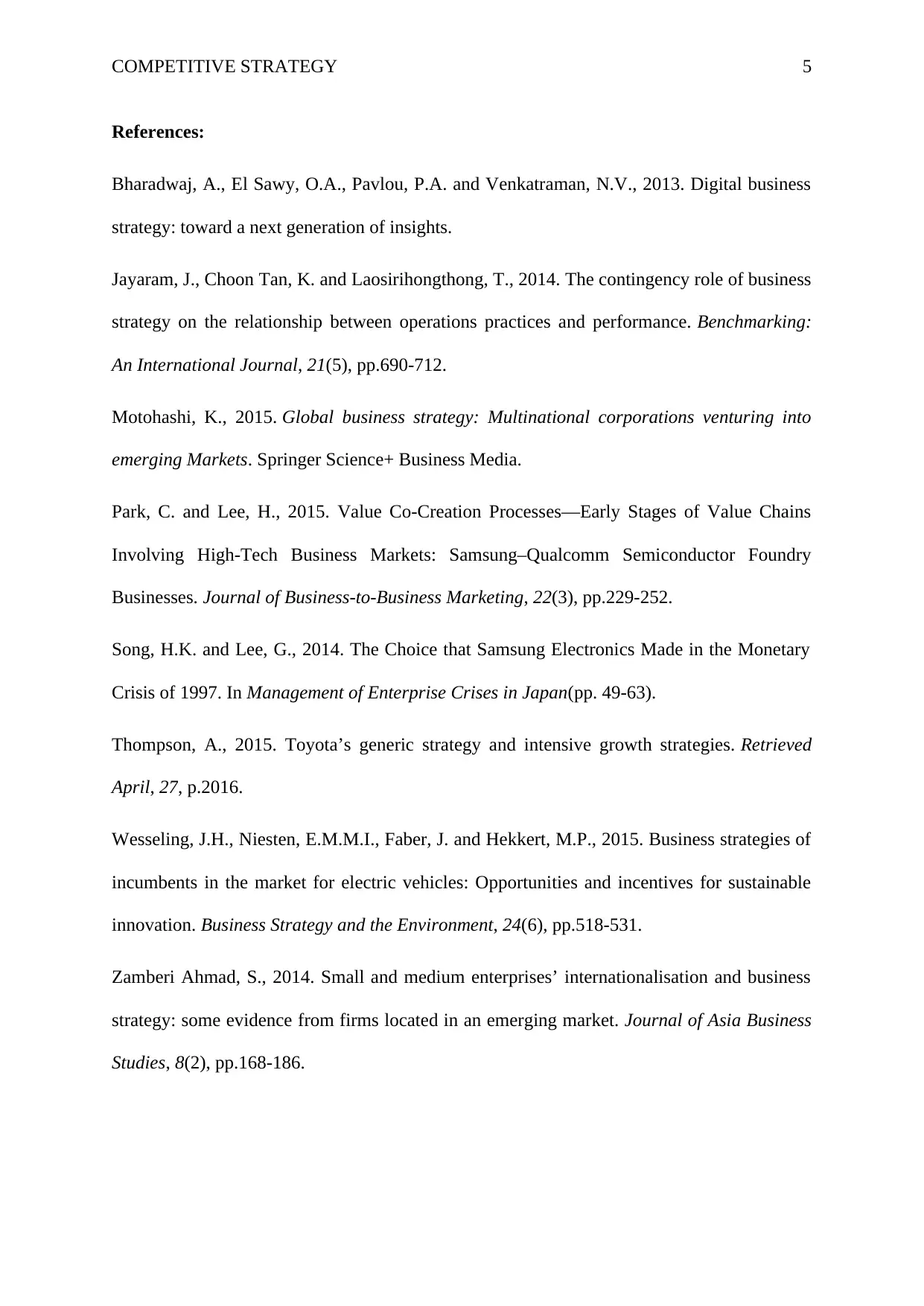
COMPETITIVE STRATEGY 5
References:
Bharadwaj, A., El Sawy, O.A., Pavlou, P.A. and Venkatraman, N.V., 2013. Digital business
strategy: toward a next generation of insights.
Jayaram, J., Choon Tan, K. and Laosirihongthong, T., 2014. The contingency role of business
strategy on the relationship between operations practices and performance. Benchmarking:
An International Journal, 21(5), pp.690-712.
Motohashi, K., 2015. Global business strategy: Multinational corporations venturing into
emerging Markets. Springer Science+ Business Media.
Park, C. and Lee, H., 2015. Value Co-Creation Processes—Early Stages of Value Chains
Involving High-Tech Business Markets: Samsung–Qualcomm Semiconductor Foundry
Businesses. Journal of Business-to-Business Marketing, 22(3), pp.229-252.
Song, H.K. and Lee, G., 2014. The Choice that Samsung Electronics Made in the Monetary
Crisis of 1997. In Management of Enterprise Crises in Japan(pp. 49-63).
Thompson, A., 2015. Toyota’s generic strategy and intensive growth strategies. Retrieved
April, 27, p.2016.
Wesseling, J.H., Niesten, E.M.M.I., Faber, J. and Hekkert, M.P., 2015. Business strategies of
incumbents in the market for electric vehicles: Opportunities and incentives for sustainable
innovation. Business Strategy and the Environment, 24(6), pp.518-531.
Zamberi Ahmad, S., 2014. Small and medium enterprises’ internationalisation and business
strategy: some evidence from firms located in an emerging market. Journal of Asia Business
Studies, 8(2), pp.168-186.
References:
Bharadwaj, A., El Sawy, O.A., Pavlou, P.A. and Venkatraman, N.V., 2013. Digital business
strategy: toward a next generation of insights.
Jayaram, J., Choon Tan, K. and Laosirihongthong, T., 2014. The contingency role of business
strategy on the relationship between operations practices and performance. Benchmarking:
An International Journal, 21(5), pp.690-712.
Motohashi, K., 2015. Global business strategy: Multinational corporations venturing into
emerging Markets. Springer Science+ Business Media.
Park, C. and Lee, H., 2015. Value Co-Creation Processes—Early Stages of Value Chains
Involving High-Tech Business Markets: Samsung–Qualcomm Semiconductor Foundry
Businesses. Journal of Business-to-Business Marketing, 22(3), pp.229-252.
Song, H.K. and Lee, G., 2014. The Choice that Samsung Electronics Made in the Monetary
Crisis of 1997. In Management of Enterprise Crises in Japan(pp. 49-63).
Thompson, A., 2015. Toyota’s generic strategy and intensive growth strategies. Retrieved
April, 27, p.2016.
Wesseling, J.H., Niesten, E.M.M.I., Faber, J. and Hekkert, M.P., 2015. Business strategies of
incumbents in the market for electric vehicles: Opportunities and incentives for sustainable
innovation. Business Strategy and the Environment, 24(6), pp.518-531.
Zamberi Ahmad, S., 2014. Small and medium enterprises’ internationalisation and business
strategy: some evidence from firms located in an emerging market. Journal of Asia Business
Studies, 8(2), pp.168-186.
⊘ This is a preview!⊘
Do you want full access?
Subscribe today to unlock all pages.

Trusted by 1+ million students worldwide
1 out of 6
Related Documents
Your All-in-One AI-Powered Toolkit for Academic Success.
+13062052269
info@desklib.com
Available 24*7 on WhatsApp / Email
![[object Object]](/_next/static/media/star-bottom.7253800d.svg)
Unlock your academic potential
Copyright © 2020–2025 A2Z Services. All Rights Reserved. Developed and managed by ZUCOL.





